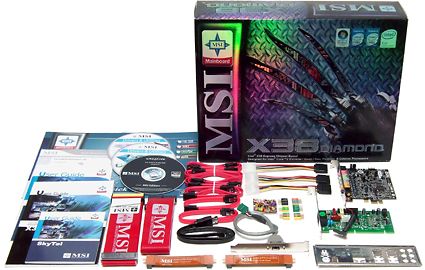X38 Comparison Part 2: DDR3 Motherboards
BIOS And Overclocking
The X38 Diamond provides almost every setting necessary to extract the highest overclock from any CPU, save for front side bus voltage, which we didn't find. Still, it overclocked better than many boards that use FSB voltage adjustments to increase maximum stable clock speed.
| BIOS Frequency and Voltage settings (for overclocking) | |
|---|---|
| FSB Frequency | 200 - 800 MHz (1 MHz) |
| Clock Multiplier Adjustment | Yes |
| DRAM Frequency | FSB clock x 1.0, 1.2, 1.5, 1.60, 2.0 |
| PCIe Clock | 100 - 200 MHz (1 MHz) |
| CPU Vcore | 1.3000 - 2.0750 Volts (0.0125 Volts) |
| CPU FSB Voltage | Not Available |
| Northbridge (MCH) | 1.200 - 1.580 Volts (0.032 Volts) |
| Southbridge (ICH) | 1.50 - 1.62 - 1.80 Volts (0.03/0.06 Volts) |
| DRAM Voltage | 1.50 - 2.50 - 2.75 Volts (0.0425/0.0850 Volts) |
| CAS Latency Range | |
| tCAS: 5-10; tRCD: 3-10; tRP: 3-10; tRAS: 9-31 |
We reached 512 MHz FSB clock (FSB2048) using our E6750 at 1.60 V and its stock 8x multiplier, giving us an overclocked speed of 4.1 GHz. The 1.60 V reading came at a BIOS setting of 1.575 V. Increasing the set voltage to 1.60 V provided a tiny increase in achievable clock speed, but violated our 1.60 V limit.
Dropping the CPU core multiplier to 6x allowed us to set up a stable bus speed of 541 MHz. This bus speed has only recently been exceeded by the Asus Maximus Extreme, but the competitor couldn't achieve the same 4.1 GHz CPU clock.
Testing the MSI X38 Diamond wasn't without its problems, however, as the 2:1 DRAM:FSB ratio caused instability at 1333 MHz. Loosening up the timings helped, but we ended up testing the base speed using an 8:5 DRAM:FSB ratio (1.60x memory multiplier) for DDR3-1066 speed at CAS 5-5-5-15.
Again, overclocking never allowed the memory data rate to be completely stable at speeds exceeding 1300 MHz, and we were forced to drop the DRAM:FSB ratio to 6:5 (1.20x memory multiplier) at CAS for benchmarking at the overclocked speed. Because the system was tested at a much lower memory data rate than those to which it was compared, it was able to maintain CAS 5-5-5-20 even at its maximum CPU speed.
Accessories
| Accessories | |
|---|---|
| Documentation & Software | Motherboard ManualQuick Installation GuideVoIP Card User's GuideX-Fi Xtreme Audio User's GuideMotherboard Driver CD (Windows XP)Motherboard Driver CD (Windows Vista)X-Fi Xtreme Audio Driver CD |
| Hardware | 1x 80-conductor Ultra ATA cable, Round1x Floppy Cable6x SATA Data Cable1x eSATA to SATA Data Cable3x Four-Pin to SATA Power Adapter1x Front Panel Quick Connector Kit1x Port Breakout Plate (2x USB, 1x IEEE-1394)2x CrossFire Bridge1x X-Fi Xtreme Audio PCI-Express Card1x VoIP Telephony Adapter Card1x I/O Panel Shield |
Rather than put its drivers on DVD, MSI includes three CDs to address Windows XP, Windows Vista, and the X-Fi Extreme Audio card separately.
The X-Fi Xtreme Audio PCI Express and SkyTel VoIP interface cards are certain to get the most attention, but also unique is the inclusion of two CrossFire bridges. ATI graphics buyers are normally forced to buy a "CrossFire Edition" card to get the bridges, but MSI's decision to include them means that CrossFire builders can make do with two "standard" cards.
Get Tom's Hardware's best news and in-depth reviews, straight to your inbox.

